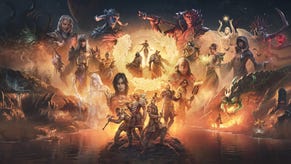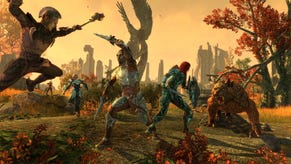Hands-on: The Elder Scrolls Online
extinguishing the flames with a bucket of water
The Elder Scrolls Online is in the unusual (and perhaps unenviable) position of having to appeal to two kinds of player – fans of the Elder Scrolls series and fans of the MMO. It would be silly to argue against the suspicion that, at a certain point, these two groups must overlap. It’s that sweet spot of the Venn diagram that Zenimax is pitching to with its foray into the lots-of-people-fighting-at-once genre. It has already been pointed out that TESO looks to be leaning towards the tried and tested techniques of the MMO, rather than forging a distinct multiplayer world from Elder Scroll conventions, a la the broken yet personable Mortal Online. Having recently had a brief wander in Tamriel, it does seem to us that, as a game, it is certainly more World of Warcraft than Skyrim. Even if it does pay tribute to its forebears in terms of lore and world-building.
Set 1000 years before the events of Skyrim, Tamriel is in the midst of a Game of Thrones-like struggle for the emperor’s seat. The world has broken off into three alliances (thus the tri-bestial ouroboros of the logo). Each alliance contains in itself a triumvirate of races. There is the Daggerfall Covenant in the west (Breton, Redguard and Orc), the Ebonheart Pact of the north and eest (Nord, Argonian and Dark Elf), and the Aldmeri Dominion of the south and south-west (High Elf, Wood Elf and Khajit). Given the strong undertone (read: overtone) of racial tension in the Elder Scrolls series so far, it’s fun to imagine what brought such misfit groups of people together. But it isn’t necessary to indulge the backstory – it is more a way of creating fertile ground for grand PvP encounters, since the central continent of Cyrodiil, from Oblivion, is set as the battleground over which the different alliances will fight for control.

Little of the PvP aspect was shown in our demonstration, however, and we’ll have to rely on a balance of marketing material and healthy scepticism to get a sense of what the sieges and battles will come to look like. The developers plan to have ‘keeps’ over which groups of players can fight, and close to each keep will be a set of resource-granting buildings such as lumber mills, farms and mines. These outlying resources will reinforce the keep (the lumber granting stronger doors and the mines granting stronger walls, for example) in a way that hopes to encourage players to see these places as strategic points worth protecting on a grander scale. PvP will be playable from an early point, Zenimax have promised, and you will be able to fight on behalf of your alliance starting from level 10.
The nature of that fighting is almost fully Warcraftian, in the sense that there’s a hotbar of six skills with the requisite cooldown timers. But there is also a basic swordplay to the combat, which means a lot of left-clicking to slice or fire a spell and a lot of right-clicking to block with the shield, if you have one. There’s also a fairly easy-to-use ‘interrupt’ move that can counter enemy NPCs. In our case this took the form of a satisfying shield bash – one of the more useful nods toward the franchise’s traditions.

Weapons and armour are a similar half-way house. Your character won’t be the only one sucking up XP. Weapons themselves will level up and be granted skills. This means that you can train with a staff until it becomes high enough to use a special flame attack, but you cannot then use that attack without the staff itself. The skills and attributes of your character are therefore spread into two pools – your equipment and your ‘self’. Armour comes in the three forms of the Scrolls’ tradition – light, medium, heavy – and, like weapons, each has its own line of upgrades which will prove to be useful to a certain archetype. For instance, progression with heavy armour will eventually grant bonuses in healing, whereas progression with light armour will grant bonuses to magicka regeneration.
Sadly, we didn’t get the chance to play with a ranged character, so the exact feel of firing bows or bolts of lightning at an enemy is something we would be keen to discover, since archery and staves requiring player-skill and accuracy have always been a staple of the series. The developers have said that ranged characters will still need to be aiming at their target but we can’t say as to how accurate such aim is required to be. There is a first-person mode – which you can enable simply by scrolling the camera to its closest position with the mouse wheel – but the game is often too crowded with enemies to forgo the use of the third-person perspective. This suggests that there will at least be some sort of aim-assist for firing projectiles. The projectiles in question will also be of the ‘magically infinite’ variety, so you won’t need to buy quiver after quiver of arrows for your longbow.

Healers, on the other hand, will have area-of-effect or cone-shaped spells and will therefore have to stay within a good sphere of their party, rather than sniping health into people from afar. There is also a ‘synergy’ system, which allows characters to buff each other and lend support roles without sacrificing their own battle input, so to speak. Although, this synergy system was a little hard to work out and we were unable to put them into practice during our short demo. Needless to say, the exploitation of this system will be most important to those parties looking to dive into the dungeons for later-level loot than those looking to explore the continents.
That sense of exploration is something Zenimax want to emphasise. The likely reason being that they know Elder Scrolls fanatics to be curious trailblazers at heart. There certainly is a lot of landmass to cover – comprising the land from all the previous games combined, plus more – but it’s how this landmass is to be populated that will determine how successfully sated the hungers of these trailblazers will be (or how satisfied the explorer ‘subgroup’ of the MMO community will be, for that matter). It’s been a common criticism of the single player Elder Scrolls games that – although the worlds are huge, the geography stunning, and the architecture fantastic – there is a serious lack of character among the majority of the quest-giving caste and other NPCs. Obviously, this being Elder Scrolls *Online*, it can rely on the human element to pick up the slack, but that doesn’t make the first staid fetch-quest we encountered during our playthrough any more enjoyable, even if it was dressed up in a murder mystery plot and one of the characters was a dog.

The sense of progressing through the world in a geographical sense is perhaps more gratifying, since each village or town you arrive at appears to have a single big problem for you to solve. The first village we came across, just outside the city walls of Daggerfall, was being torched by imps that had to be eradicated at the same time as extinguishing the flames with a bucket of water filled from the village well. The next town we stopped in had been taken over by High Rock bandits, who would only attack if provoked but would eventually have to be ousted to give control back to the townspeople. It’s not hard to imagine this process repeating itself for every settlement along the way and it might get tiresome to be greeted as the ‘one and only hope’ to every single town when you know all along that there are several thousand other people being hailed in the same way. But that is more a perpetual problem of inconsistency with the genre, as opposed to being one specific to this game and, in fairness, there are offenders a lot worse than the Elder Scrolls in this regard. And you can always simply walk past or through a town without bothering the questfolk.
This is what we did with the rest of our time, reaching into the swamps of a place called Hag Fen and darting between crocodiles and necromancers that were much too powerful for us to take on at our level. It resulted in an experience that felt more like survival against trope than anything, but the discovery of a couple of secret chests along the way which required lockpicking to open was a welcome distraction, as was the satisfaction of plotting a mark on the map and gaining XP simply by discovering an encampment, monument, hamlet or dungeon entrance.
Eventually, we reached the end of the playable world, where the walls started melding with the statues they were supposed to support and all signs of human habitation and vegetation disappeared, bar three or four cornstalks next to an abandoned plough in the middle of a wide, fenceless plain. At the end of this plain the earth came to an abrupt halt and everything dropped into a sky-coloured void. It was here we ran out of time for the demo, so we never got the satisfaction of leaping into said void. Here I should note that Zenimax were showing a self-contained test build to us so, obviously, the final game is unlikely to contain such a phenomenon. But it is perhaps representative, in some metaphorical way, of the size of the task Zenimax has taken on with the fantastical world of Tamriel, and of the work the studio has yet to do.
The Elder Scrolls Online is currently taking beta sign-ups.








